| Please access the following URL if you want to secure using SSL. All pages in the site will be secure pages. |
| https://secure02.blue.shared-server.net/www.fish-food.co.jp/message english 12.2019.html |
Welcome to FISH FOOD TIMES
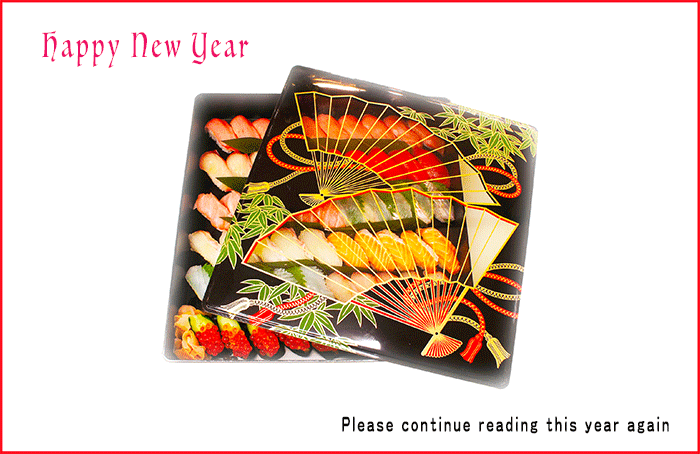
Jan. 2020 issue No.193

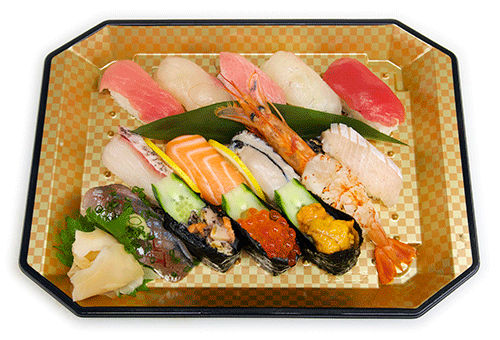
The charm of fish shop sushi
Expensive special order dishes of assorted sushi are selling well
In recent years, it seems that more and more people are buying sushi in the New Year's position like "Osechi". At the fish shop sushi section of the supermarket, which is open from New Year's Day or the 2nd, stores that sell luxurious special order dishes of assorted sushi, etc., continue to steadily increase sushi sales every year. It seems that this is not unrelated to the trend of the times that the New Year's Osechi is not something to make, but something to buy, and it is thought that the number of people who purchase special order dishes of assorted sushi as a kind of Osechi is increasing .
The price of osechi's Nest of boxes is 10,000 yen, which is cheaper, and a set of 20,000 or 30,000 is sold at an unusual price. Basically, the ingredients are seasoned with soy sauce, salt, sugar, vinegar, etc., and made to last a long time, and the balance between price and content varies greatly depending on the manufacturer. It seems that there is a tendency to be guided to a high-priced range where people can feel safe in many ways.
In an era where "purchase osechi" is commonplace, most osechi are made by freezing and reconstituting frozen materials mass-produced by manufacturers at the manufacturing site or purchasing frozen osechi Products to be thawed and eaten. They have few homemade dishes, and their content is not something they want to eat at a meal. So kids with a luxurious tongue today are not always willing to eat expensive osehi dishes on the New Year's table. In extreme cases, children who do not care about the price of food want to eat " warm cup ramen than osechi '', a phenomenon that is disappointing for parents who use large amounts of money for osechi Is not unusual.
Under such circumstances, fresh order special dishes of assorted sushi mainly consisting of raw fish are available for less than 10,000 yen, and families gathered at home and eat this at home dining table without going to the store It can be done. The special order dishes of assorted sushi are more pleasing to young and old, including children as well as adults, than osechi, who has no sense of freshness, who must spend 20,000 to 30,000 yen.
For example, the following image posted at the top of the page is a special order dishes of assorted sushi of 9,800 yen with 60 cans that are actually sold at the store where the author is instructed by the fisheries department, this is the author Created as a model product. There are plenty of raw fish sushi, including raw bluefin tuna ootoro and cyutoro, so the weakness for children with rich tongues will probably eat ahead. Perhaps the adults together at the table will have a hard time stopping that movement.
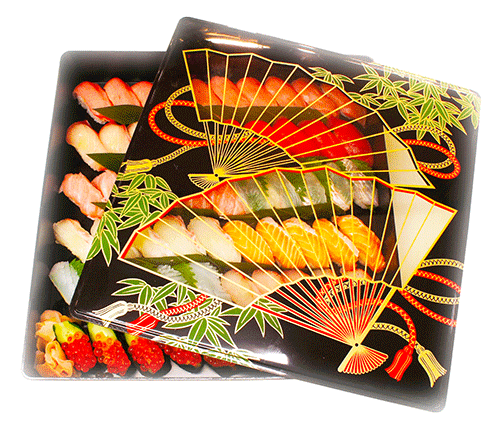
The store that sells this product sells it only in the form of a pre-order, and I was surprised at the number of orders received during the New Year's holiday last year. This year, since the start of reservations, it has far exceeded the pace of last year, the growth is not ordinary, and it is impossible to imagine how much reservations will be placed. The same phenomenon is occurring not only in this store but also in other companies that I amrelated with.
I wrote that similar phenomena are occurring at other companies, but I am not a related company at all, and it is true that there are stores where there are still no pre-orders.
This is thought to be due to the difference in the attitude of approaching fish shop sushi, and it seems that the difference in the phenomenon is whether the company or shop has a serious intention to strengthen fish shop sushi.
Products like fish shop sushi, which is an extension of side dish sushi
It is not easy to sell the special order dishes of assorted sushi with a selling price of 9,800 yen in the above image at the fish counter, and it is still a decent sushi product sales record and the credit built up with the passage of time based on that Is required. Their achievements and credibility are based on the accumulation of daily business, and by spending time in a serious attitude toward the real thing, products with such a selling price can be sold.
However, at supermarkets where the author sometimes visits and inspects various parts of the country, unfortunately, I often see "side dish sushi that resembles fish shop sushi," which only has its name. Whenever I look at a fish shop sushi of such a level, I have to complain that "you can't sell because you're doing that ..."
The fish counter that sells the highly acclaimed fish shop sushi products has a very high level of sales due to a completely different quality level from such "side dish sushi that resembles fish shop sushi". And that sales are now more than one-quarter or nearly one-third of the total sales of fisheries departments, but that fact seems less known.
At stores run by companies that do not know the power of Uoya sushi, it seems that they do not understand how much of the fish shop sushi product range is growing in the fisheries sector. So, based on the current sushi sales in the side dish section, it seems that even if fish shop sushi is strengthened, it seems that it is only slightly better than side dish sushi.
One of the most common examples of companies that neglect the power of fish shop sushi is that they say "Products like fish shop sushi, which is an extension of side dish sushi" by themselves as a fish shop sushi. As the actual situation, in many cases, sushidane is taken out of a vacuum bag manufactured by an external manufacturer on the right of the lower image and put on a rice ball, which is almost the same as side dish sushi like the left image below. Today's customer who had a good palate will not appreciate sushi products that have done such a deception by cheap tricks, and sales are not expected to increase.
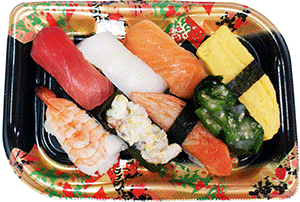
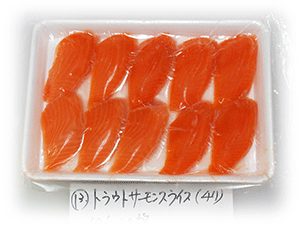
Many companies that sell "Products like fish shop sushi, which is an extension of side dish sushi" operate a fish shop sushi counter with only a small number of parts, such as one person. Because of this, the content of the product is limited in terms of time and capacity, and limited staple items mainly made of frozen sushi are repeated in the same way every day, so they are almost unchanging and unattractive, As a result, sales are hard to increase.
If the company really wants to strengthen fish shop sushi, it would be better to have at least two people instead of leaving only one part-time employee to do the sushi work, for a total of three people. Also, if the company has three staff members for sushi work during the day and holidays and special events, two or more people can actively work on elaborate work that can not be done by one person alone. In other words, the product level can be raised significantly, and there is a possibility that sales will increase significantly.
However, it is not often that management understands this "importance of the number of people." And since we have to work on the minimum number of fish shop sushi under the name of labor saving, efficiency, and rationalization, the end result is "Products like fish shop sushi, which is an extension of side dish sushi "level. Under such circumstances, it is difficult to increase the sales of sushi in the fisheries department.
how to get the feeling of fish shop sushi
So, if the company wants to increase the sales of sushi products in the fisheries department, the fish shop sushi has to be well thought out. For example, what are the merits of a fish shop making sushi, what kind of content can differentiate side dish sushi, and how to promote cost performance more than sushi specialty stores, Japanese restaurants, conveyor belt sushi restaurants, home delivery sushi restaurants, tavern, etc. The answer will come naturally if you think about it.
Considering the merits of fish shop sushi being a fishery department, first of all, you will get fresh raw fish that is possible only in a fish counter. And if the market price drops occasionally and you can use the cheap raw fish that you can get, you should be able to make full use of the real pleasure of fish shop sushi. Also, blue fish, which are relatively stable at relatively low prices, change color quickly and are difficult to handle, so this should be able to take advantage of fish shop sushi as a material that fisheries departments are good at.
For example, the image below is a relatively small bonito caught in early summer, cut into sushidane without removing the abdominal skin, and commercialized as "Silver skin nigiri sushi plenty of raw bonito". I remember that the purchasing cost was quite low, so even a selling price of 580 yen per pack was a product cost with a sufficient markup ratio.
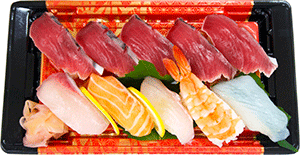
This is a sushidane product that uses the technique of “ginkawatsukuri”, which is only possible for fresh bonito with good freshness, to make sashimi while leaving the skin. The point is that even if you add 5 kan of different kinds of nigiri sushi to the container and calculate the markup ratio, you can sell it for 580 yen with 10 cans, and if you make it a selling price of 980 yen, you can not show the characteristics of fish shop sushi. If you sell for 580 yen, you can sell 30 to 50 packs, but if you sell it for 980 yen, you will probably sell only 5 to 10 packs.
In other words, it is important that fish shop sushi uses (1) raw fish with good freshness, (2) has a large volume, and (3) keeps prices low. By doing so, you can appeal the high cost performance that can only be achieved by products made at the fish counter. Such a product with excellent cost performance is not limited to raw skipjack, but can be made with other fish, such as horse mackerel and sardine can be realized at any time if you like, and even with fish with white flesh It is not impossible depending on the market price. One of the ways fish shop sushi differentiates side dish sushi is to create a sense of freshness, volume and inexpensiveness that are difficult to achieve using frozen sushidane.
All frozen suhidane is basically thin and small cut to keep the cost as low as possible. For example, soft fish like tuna are sliced without exception, but if you cut soft fish like tuna into nigiri sushi, the taste will be greatly impaired. Fish shop sushi can make a difference to the fundamental problems of frozen sushidane.
For example, when I cut sushidane, I basically cut it around 12g. If you cut a lot of sushidane needed at the workplace, some sushidane comes out as much as 15 g and sometimes 10 g, so the total weight of sushidane mixed with such various weights is divided by the number of sheets, the average is 12 g It should be just as good. This is because even a tuna with a soft nature, if the sushidane is about 12 g in size, I think that the taste of the tuna nigiri sushi can be enjoyed.
Conversely, when it comes to hard nature amberjack and red sea bream, we think that there is no problem with a weight of 10 g, and if you want to make the abdomen of such a hard nature fish into a sushi dumpling, you can only weigh 8 g We think that it is accepted as sushi. In other words, fish shop sushi should change the way of cutting sushidane depending on the difference of fish meat properties, and by changing the way of cutting depending on the part of the fish as well, you can taste the original taste of the fish.
On the other hand, the image below shows a raw yellowfin tuna cut as a sushidane, but this image uses a technique that can't be imitated if a tick frozen tuna is cut by a machine. Do readers know that?
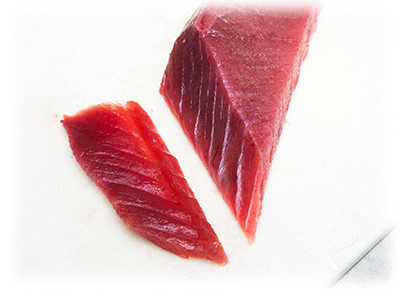
I'm sorry if this image is not clear or if the technology is pointed out halfway, but the answer is that I use the "erect koba" technology. koba is the "small blade" at the tip of the knife, which is a technique for making a sushidane with a yanagiba knives by setting the blade just before the end of cutting. This is called "kobatate" or it stands up to return the knife blade, so it is also expressed as "kobagaeshi".
If the results of the koba technology are obtained from a machined sushidane that requires the efficiency of cutting frozen tuna in one minute, it is thought that as soon as the efficiency is reduced, the manufacturing cost must be increased. I don't think it's likely that frozen sushidane will have a product with koba in the future. It is unlikely that customers will check for koba when buying nigiri sushi at the fish counter, but the sushidane with koba looks a little thicker, which makes the sushidane too wide It is easy to make the size of the uniform width by applying the brakes, and it will definitely improve the appearance of nigiri sushi as a whole.
Appearance is also important
Now that the appearance has come up, let's talk about that a bit. After all, the typical unsightly one is "nose sushi". If you put such an image on the page of this month's issue, the character will be reduced and it will be described in text. When making a product, the sushidane is placed on the rice ball from the left side of the container, and in that order, any sushidame remains on the left side. So it's easy to see the sushi on the rice ball without having to do "to make hand-roll" work on the sushi, and this weird looking product is really the worst. It is presumed that almost 100% of the work on side dish sushi is performed in this nose sushi, but that is good because side dish sushi is originally like that. But I want fish shop sushi to achieve a completely different level than nose sushi.
In the case of fish shop sushi, the least hope is that even if the worker is a beginner, it is inevitable to omit the process of to make hand-roll sushi, and if you take the method of putting sushidane on a rice ball, Let's avoid sushidane on the right side from nigiri sushi on the left side of the container. For that purpose, it's always good to have the worker "finish with a finger" at the last stage, and the appearance will be quite different depending on whether or not this last is done.
Also, I think the following is a sense of incongruity that comes from my own aesthetic sensation about the appearance of the product, but it is made of vinyl chloride, which is generally used as a lunch box for side dishes and a partition between rows of side dish sushi products Looking at the products that use the "long mountain-shaped partition" in fish shop sushi, I feel that fish shop sushi is doing such a thing and can differentiate side dish sushi. I feel that the green color of that long partition is an artificial color that is too unnatural, so if I sandwich it between sushi and fresh raw fish, I think that it will impair the freshness of fish shop sushi.
For this reason, at my company fish shop sushi, where I am involved for guidance, I cut a leaf of kumasasa, a natural product with a natural green color, according to the size of the product and cut it as shown in the image below, It is strongly recommended that they be used for partitioning in a way.
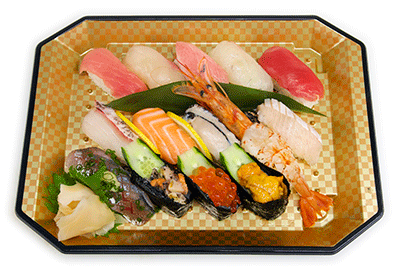
The nigiri sushi in the above image was created by the author as a model of the special nigiri sushi. If the natural shade of a leaf of kumasasa contained in this contains a long mountain-shaped partition with a very artificial and unpleasant shade, then the extraordinary level product will be a normal level product.
A leaf of kumasasa is an inexpensive substitute for the barroom plant originally used in sushi restaurants, and it is said that barroom plant and a leaf of kumasasa have a certain antiseptic effect. -I think that it is gentler on the human body than a long mountain-shaped partition. If a leaf of kumasasa is not prepared or out of stock, if you use leaves of perilla as an alternative at least, I think that you can get a fish shop sushi more than using a long mountain-shaped partition.
In addition, this is not just the appearance, but the product in the image above does not have the gari (sweet vinegar ginger) in a small plastic bag, which is usually attached to side dish sushi, and is accompanied by a gari that is not in a bag . I also argue that fish shop sushi should use such a "baragari" (meaning disjointed stategari, which cannot be packed in one bag). Because the contents of the bagged gari are originally ginger in a ragged shape, sliced thinly with a slicer, and only the smallest gari, which is the least valuable product among the cut ginger slices, is placed in a sachet. Because it is included. For those who really like gari, they shouldn't want to eat this kind of garbage at the bottom, and believe that fish shop sushi products should be differentiated by adding a decent form of gari.
Gari in plastic bags are only artificial appendages, so we don't want to make them stand out in the product from an aesthetic sense. However, in the case of baragari, one of the product contents can be positioned as "ashirai", so I think that the presence of baragari does not impair the appearance of the product, It is one of the ways to improve the appearance.
It failed to adapt to changing times
By the way, at the beginning of the year, one aspect of what fish fish sushi should be has been described so far. Regarding the theory that fish fish sushi should be, in FISH FOOD TIMES, January 2018 No.169 "Style of fish shop sushi" (Still not notice? The merit of fish shop sushi ...) This month's issue is intended to minimize the duplication of the description at that time, and will focus on what was missing at that time. Where possible, readers should read both articles together to better understand what I want to express. I would like you to look back two years ago, but the following is likely to be the same as the article two years ago. If there is a part of the article overlaped, please think that it is the content that I particularly want to appeal.
Originally, the main audience of this website is assumed to be all those who work at the fish counter. In addition, it is assumed that there are management positions that are in charge of managing the fish section, supermarket managers, department store tenant fish section managers, and hopefully presidents and executives who run supermarkets. But this month's issue is intended to be read by people at the company's management level. The January issue of FISH FOOD TIMES two years ago introduced above was an article that wanted management-level people to understand my thoughts on fish shop sushi. This is the second time.
The reason why I want people at the management level to read it is that I am very worried that "the presence of the fisheries sector is becoming weaker" in the supermarket format.
There is no doubt that the fish counters in supermarkets in recent years have not gained much momentum and their presence has been lost as in the past, but due to such lonely phenomena, the fish counters are in a declining department with no future prospects, I am very irritated to take such a view.
The author introduced specific examples that can still activate the fish counter in one way in FISH FOOD TIMES January 2018 No.169 and January 2019 No.181. I also wrote the same thing on the special contribution page for the March 2019 issue of the monthly magazine "Food Commerce". Based on the case, the monthly magazine "Food Commerce" in the October, 2019 issue also argues that the fish counters in each region of Japan can be considered as a cause of the lack of energy.
To put it simply, he pointed out that the supermarket's fisheries division was based on "It failed to adapt to changing times." The following is an excerpt from the monthly magazine "Food Commerce" October 2019 issue describing this fact.
| Excerpt from the monthly magazine Food Commerce |
<… Omitted> Especially in the fresh fish sector, “strengthening of ready-to-eat products” should be implemented. Sashimi and sushi are representatives of ready-to-eat products in the fresh fish category, and fish side dishes are also included. According to the author, who naturally considers the existence of fish shop sushi as a matter of course, the fact that there are many supermarkets that have not yet worked on "fish shop sushi" from a national perspective, It is a fact that a big question cannot be forbidden. Why there are still supermarkets that do not work on fish shop sushi ... this is a typical example of "It failed to adapt to changing times" in the fresh fish sector. If there is a supermarket owner who thinks that sushi is enough for a side dish sushi, the customers who use that shop are pathetic. Basically, as a product level, fish shop sushi and side dish sushi are completely different things, and in the future side dish sushi is definitely destined to be swept away and culled out by fish shop sushi that has earnestly focused. The side dish section will have to survive only by selling some inexpensive sushi products such as Inari sushi. It is not unusual for fish shop sushi to account for more than 20% of the total sales of fresh fish in the fresh fish section, and there are over 25% of stores that are not only fish counters but also signboard products. In addition, the sales of the fish shop sushi product group usually continue to grow without breaking the previous year, and the stores that have succeeded in working on fish shop sushi do not reduce the in-store composition ratio of the fresh fish section due to the presence of this growing product group. In order not to further dilute the presence of fish counters, it is necessary to adapt to the changes of the new era by strengthening the efforts of fish shop sushi, one of the ready-to-eat products. |
As described in this sentence, if you think that the era demands the ready-to-eat products and think carefully about what the ready-to-eat products can respond to in the fisheries sector, everyone should be aware that you can't talk without fish shop sushi or fish side dishes as the destination.
However, even at the moment of entering the new era of Reiwa, we know that there are still many supermarkets in the country that have not established policies that respond appropriately to that. Therefore, the author put the word "Still not notice?" In the opening title of FISH FOOD TIMES January 2018 No.169. Two years later, knowing that some companies have hardly noticed any response to this, there are those who are amazed at the insensitivity of their business sense.
The typical idea of a company that lacks awareness of sushi products in general rather than fish shop sushi and does not want to take concrete action is that sushi products should strengthen the side dish section . I have mentioned this fact many times in past articles, including this month's issue, that this idea is fundamentally wrong, so I do not want to commit. But, at least, it's worth mentioning that this misleading idea is nothing less than "helping ourselves in the decline of fisheries departments."
Fish shop sushi in the new Reiwa era
By the way, I want to close the January issue. In recent years, the January issue has been modified to be slightly different from other months. From the specifics of product proposals and the like, which are written every month, I try to take into account the concept of sales floor management and the idea of fisheries department's idea which there should be.
For this reason, there are few materials such as images and graphs and it is mainly text, so some readers feel that it is difficult to arrive at confusing contents, or that there are few photos and it is not only fun with text, I think it is. However, once a year, I want you to deviate slightly from the actual know-how on the spot, and also read conceptual ideas from beginning to end.
I'll finish that idiomatic statement soon. If your fisheries department hasn't been able to break out of the trend of declining in-store sales every year, why not seriously strengthen fish shop sushi? The fisheries department of the company I taught was strengthening the fish shop sushi, and there is no doubt that it has been increasing the in-store composition, contrary to the general trend of the whole country. So you should steer your way to strengthen your fish shop sushi to lead to a similar result.
If the special order dishes of assorted sushi with a selling price of 9,800 yen in the opening image can be sold in the future, it is certain that the decline in the fish counter will be stopped, and at that time, the fish shop sushi in the fisheries department Sales should be growing. The 9,800 yen special order dishes of assorted sushi products are not a hopeful prospect but a fact that they are still sold at a certain store, so it is impossible for your store to be that way is not. The fish counter is in a great position to sell "SUSHI", which is popular not only for the majority of men and women in Japan but also for people around the world. Hesitating to sell a product with such a great increase, just looking on with a finger in his mouth is not too wasteful.
In the new era of Reiwa, will you be ridiculed as a "department that failed to adapt to changing times", or will you just start out and take on new possibilities seriously? Which is your company? When seriously strengthening fish shop sushi, competitors do not assume low levels such as side dish sushi, but genuine sushi specialty stores and Japanese restaurants, as well as conveyor belt sushi, home delivery sushi, tavern, etc. at high level, the supermarket fish section should dig into the market share of sushi sales , and have the ambition to take away some of that market share.
If your company can work hard to strengthen fish shop sushi with such an enthusiasm, fish shop sushi should be the "savior" of the fisheries department.
An opinion and the communication are to iinfo@fish food times
Date of updating 1 Jan. 2020
